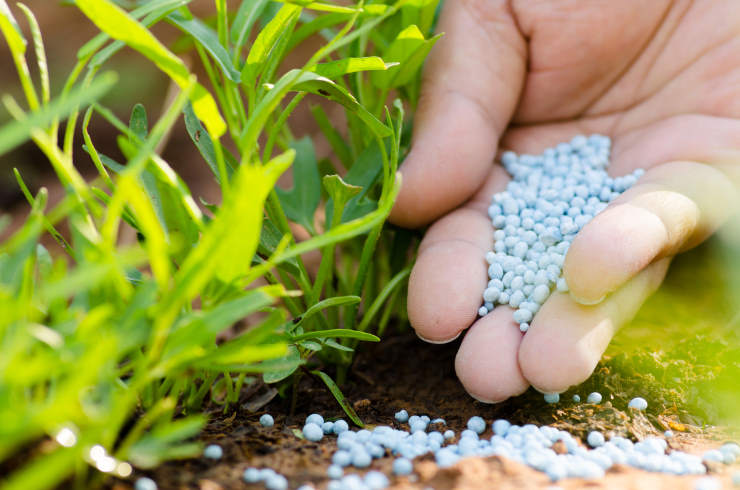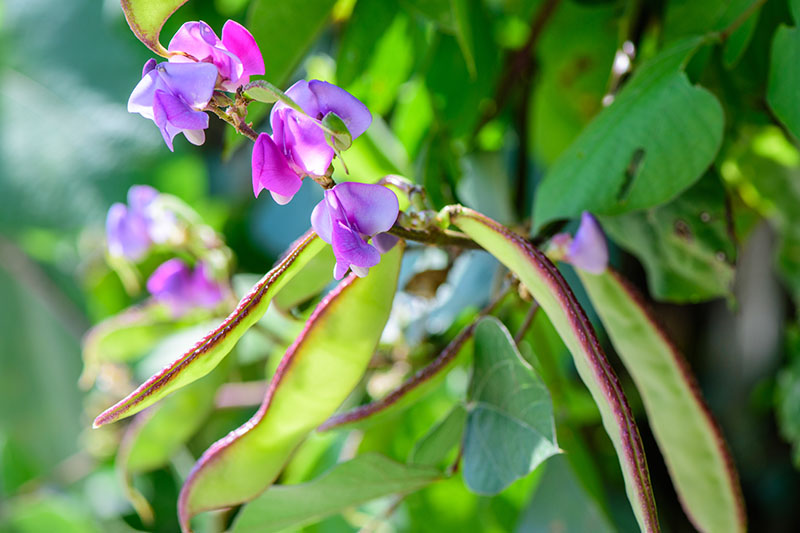Best Time to Prune Hydrangea for Optimal Growth and Blooming
Knowing when to prune hydrangeas really matters if you want healthy plants and maximize blooms. Different hydrangea types need pruning at certain times, otherwise, you might end up cutting off next season’s flower buds.
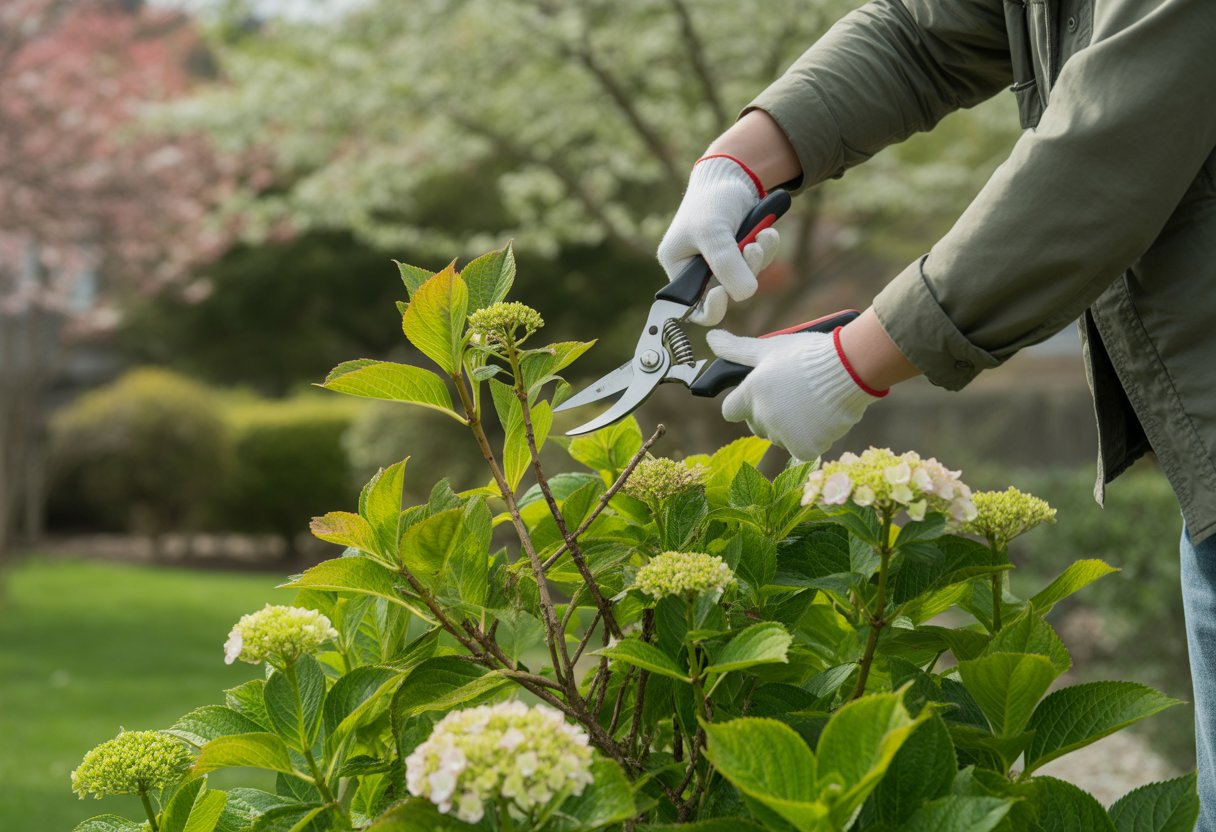
Most hydrangeas do best when pruned in late winter or early spring, before new growth kicks in. But honestly, it depends on the variety. Mophead and lacecap hydrangeas need pruning after they flower, but panicle and smooth hydrangeas can handle a good cut in early spring.
Let’s get into the specifics—because knowing the right timing can make all the difference.
Understanding Hydrangeas and Their Varieties
Hydrangeas come in all shapes and sizes, with different pruning needs. If you can identify the type you have, you’re already halfway there. Each one has quirks that affect when and how you should prune for the best blooms.
Types of Hydrangea
You’ll mostly see a few main types, split up by flower shape and how they grow.
- Bigleaf Hydrangea (Hydrangea macrophylla): Mophead and lacecap flowers, blooms on old wood.
- Panicle Hydrangea (Hydrangea paniculata): Cone-shaped clusters, blooms on new wood.
- Smooth Hydrangea (Hydrangea arborescens): Big round white heads, blooms on new wood.
- Oakleaf Hydrangea (Hydrangea quercifolia): Oak-shaped leaves, flowers on old wood.
- Climbing Hydrangea: Climbs with lacecap-type flowers.
These differences really matter for pruning methods and timing.
Key Characteristics of Popular Varieties
Bigleaf hydrangeas have those classic mophead and lacecap blooms. You need to be careful when pruning, or you’ll lose next year’s flowers. Some, like ‘Endless Summer’, bloom on both old and new wood, which makes things easier.
Panicle hydrangeas (‘Limelight’, ‘Quickfire’) grow upright and take harder pruning because they flower on new growth. They’re great in formal gardens.
Smooth hydrangeas, like ‘Annabelle’, are tough and don’t need much fuss—they flower on new wood, so you can cut them back pretty hard. Oakleaf hydrangeas stand out with their leaves and bloom on old wood, so just a light trim does the trick.
Hydrangea Growth Habits
Growth habits really shape how you should prune. Bigleaf and oakleaf hydrangeas set their buds the year before, so if you prune hard in spring, you’ll lose flowers.
Smooth and panicle hydrangeas shoot up and bloom on current season’s growth, so you can prune them in late winter or early spring and not worry.
Climbing hydrangeas cling to supports and flower on old wood. Prune them just for shape or to remove dead stuff.
When to Prune Hydrangeas for Optimal Bloom
Pruning at the right time really affects how many flowers you’ll get. Each hydrangea species has its own timing, and if you miss it, you might lose all those flower buds you were hoping for.
Best Pruning Times by Hydrangea Type
Prune bigleaf hydrangea (macrophylla) after flowering, usually early or late summer. If you cut them in spring, you’ll cut off the buds and lose blooms.
Panicle and smooth hydrangeas flower on new growth. They love a good early spring pruning—it actually helps them bloom better.
Oakleaf hydrangeas do best with a trim in late winter or early spring—just enough to shape them, but not so much you lose the flowers.
Effects of Timing on Blooms and Flowering
If you prune bigleaf hydrangeas before buds form, you’ll lose all that season’s flowers. That’s always disappointing.
For the new-growth bloomers, if you prune too late, you might cut off stems that would’ve made flowers. Pruning at the right moment gives you stronger, fuller blooms.
Recognizing Flower Bud Development
Bigleaf hydrangeas set buds in late summer or early fall, and those little rounded nodes spend the winter on the stems. Try not to cut these before spring, or you’ll regret it.
Panicle and smooth hydrangeas make their buds on new shoots every year. Buds aren’t easy to spot in winter, so prune before the plant wakes up.
It helps to look closely for buds so you don’t accidentally snip off next year’s flowers.
Seasonal Considerations
Spring pruning works best for hydrangeas that bloom on new wood. Cut before new growth starts, and you’ll get more flowers.
For old-wood bloomers, prune right after flowering, usually in early fall or summer. Avoid pruning late in the year—frost can hurt new buds.
If you live somewhere cold, don’t prune too late or you’ll risk frost damage to new buds.
Essential Pruning Techniques and Tools
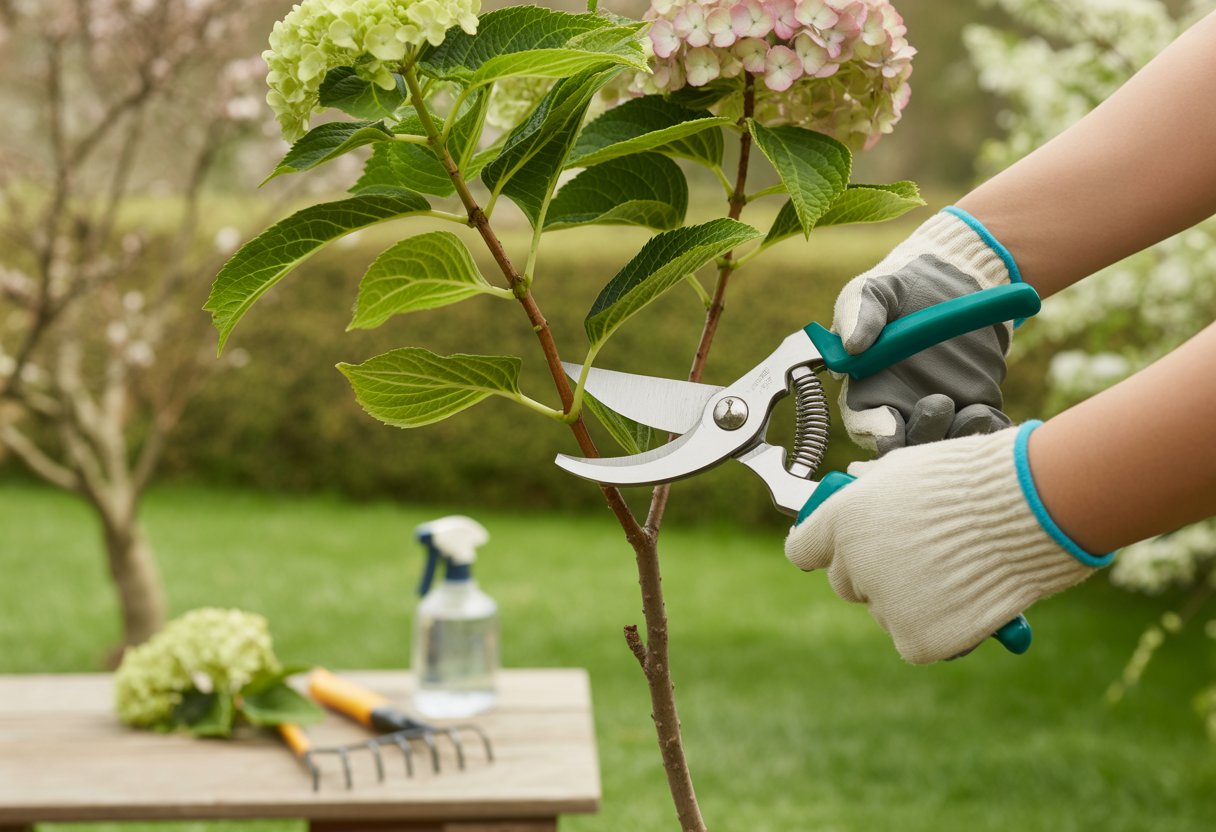
Pruning hydrangeas isn’t rocket science, but having the right tools and knowing the basics makes it a lot easier. Good tools and solid technique mean healthier plants and bigger blooms.
Choosing the Right Pruning Tools
Grab pruning shears for branches and stems up to ¾ inch thick. They give you nice, clean cuts and don’t squish the stems. If you run into thicker branches (over an inch), loppers give you more power and reach.
Honestly, stainless or carbon steel tools last longer. Keep them sharp and clean so you don’t damage stems or spread disease. Gloves help—no one likes scratches or splinters.
Step-by-Step Pruning Process
Start by cutting out any dead or damaged branches—just cut back to healthy wood. Thin out some of the oldest stems so more light and air can reach the center.
For mophead and lacecap hydrangeas, prune right after they finish flowering. For smooth and panicle types, cut them back in late winter or early spring. Don’t cut too close to the main stem—leave a little stub so it heals better.
Deadheading and Branch Management
Deadheading means snipping off spent blooms to keep the plant looking tidy and encourage more flowers. Just use pruning shears and cut at the base of the flower cluster.
Every so often, thin out crowded areas and trim back any branches that are getting out of hand. Cutting out weak or crossing branches helps air move through and keeps disease away. A little regular care keeps hydrangeas fuller and happier all year.
Aftercare and Enhancing Hydrangea Health
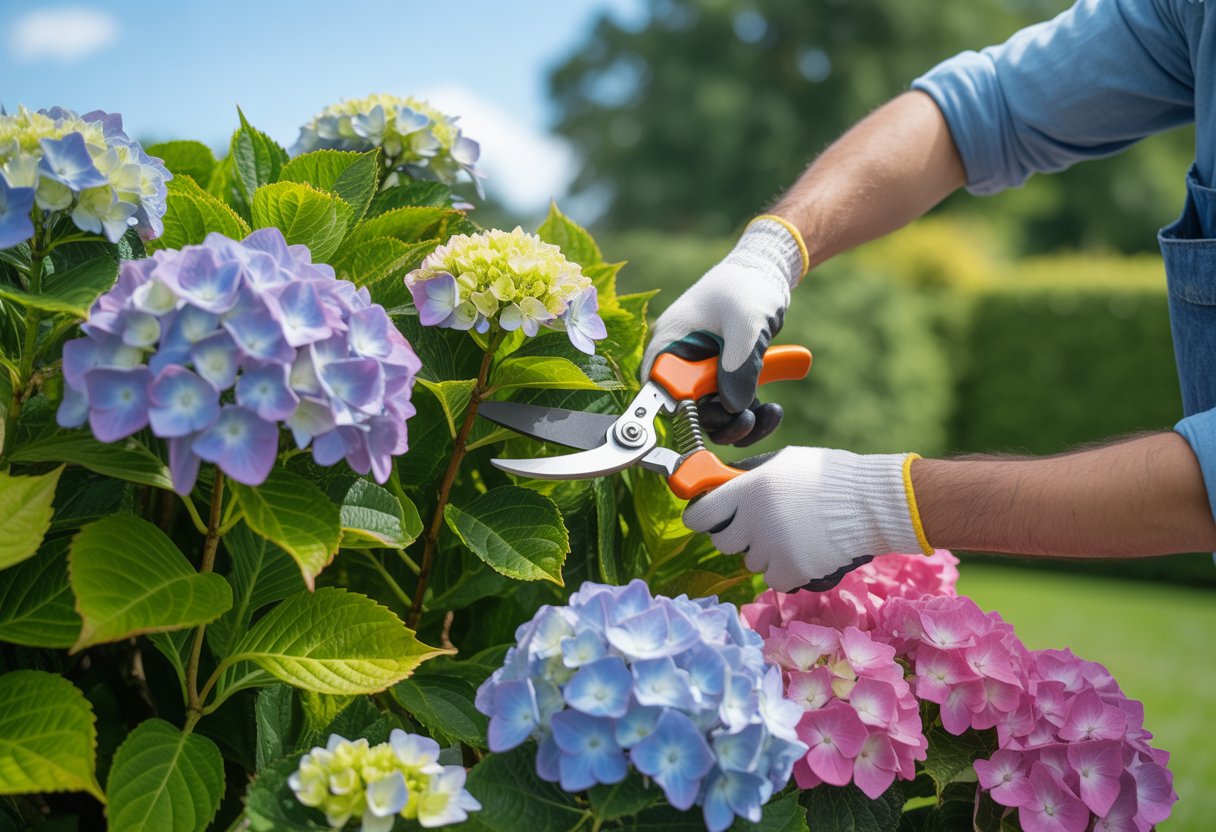
Once you’ve pruned, a bit of aftercare helps hydrangeas bounce back strong. Paying attention to soil, sunlight, and where you plant them goes a long way.
Soil and Mulch Management
Hydrangeas love well-draining, moist soil and a slightly acidic pH—somewhere between 5.5 and 6.5. You can test your soil and tweak it if you need to, maybe add sulfur to lower pH or lime to bump it up.
Spread a 2-3 inch layer of mulch to lock in moisture and keep the soil cool. Pine needles or shredded bark work well, and they help keep the soil acidic. Don’t pile mulch right up to the stems—leave a gap to avoid rot.
Water well after pruning, especially if it’s dry out. That helps the roots recover.
Light and Air Circulation Needs
Hydrangeas do best with morning sun and afternoon shade—too much heat can scorch the leaves. Picking the right spot makes a big difference.
Good air flow keeps fungal diseases like powdery mildew away. When you prune, open up the plant a bit so air moves through and leaves dry faster.
Don’t crowd your hydrangeas—give them space so they can breathe.
Integrating Pruned Hydrangeas Into the Landscape
When you’re figuring out where to put pruned hydrangeas, think about how big they’ll get. It’s easy to underestimate how much space they’ll need, and nobody wants a crowded mess.
Hydrangeas shine as foundation shrubs, border plants, or specimen features. They’ve got a way of drawing the eye, whether you tuck them along a walkway or let them steal the show in a front bed.
Try grouping hydrangeas with plants that like the same kind of soil acidity and shade. That way, your garden feels like it actually belongs together, not just a bunch of random plants.
For example, ferns and hostas complement hydrangeas in shady corners. It’s a combo that just works, especially if you want a lush, layered look.
Keep an eye on things like soil moisture, shifts in sunlight, and any signs of disease. Staying on top of these details keeps your shrubs looking good all year.

